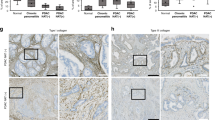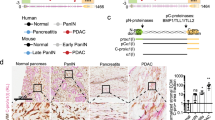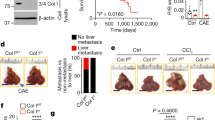Abstract
Pancreatic ductal adenocarcinoma (PDAC) is associated with a pronounced collagen-rich fibrosis known as desmoplastic reaction; however, the role of fibrosis in PDAC is poorly understood. In this report we show that collagen can regulate the tumor suppressive let-7 family of microRNAs in pancreatic cancer cells. PDAC cells growing in 3D collagen gels repress mature let-7 without affecting the precursor form of let-7 in part through increased expression of membrane type 1-matrix metalloproteinase (MT1-MMP, MMP-14) and ERK1/2 activation. PDAC cells in collagen also demonstrate increased TGF-β1 signaling, and blocking TGF-β1 signaling attenuated collagen-induced MT1-MMP expression, ERK1/2 activation and repression of let-7 levels. Although MT1-MMP overexpression was not sufficient to inhibit let-7 on 2D tissue culture plastic, overexpression of MT1-MMP in PDAC cells embedded in 3D collagen gels or grown in vivo repressed let-7 levels. Importantly, MT1-MMP expression significantly correlated with decreased levels of let-7 in human PDAC tumor specimens. Overall, our study emphasizes the interplay between the key proteinase MT1-MMP and its substrate type I collagen in modulating microRNA expression, and identifies an additional mechanism by which fibrosis may contribute to PDAC progression.
This is a preview of subscription content, access via your institution
Access options
Subscribe to this journal
Receive 50 print issues and online access
$259.00 per year
only $5.18 per issue
Buy this article
- Purchase on Springer Link
- Instant access to full article PDF
Prices may be subject to local taxes which are calculated during checkout




Similar content being viewed by others
References
Aoyagi Y, Oda T, Kinoshita T, Nakahashi C, Hasebe T, Ohkohchi N et al. (2004). Overexpression of TGF-beta by infiltrated granulocytes correlates with the expression of collagen mRNA in pancreatic cancer. Br J Cancer 91: 1316–1326.
Bloomston M, Frankel WL, Petrocca F, Volinia S, Alder H, Hagan JP et al. (2007). MicroRNA expression patterns to differentiate pancreatic adenocarcinoma from normal pancreas and chronic pancreatitis. Jama 297: 1901–1908.
Dangi-Garimella S, Redig AJ, Shields MA, Siddiqui MA, Munshi HG . (2010). Rho-ROCK-myosin signaling meditates membrane type 1-matrix metalloproteinase-induced cellular aggregation of keratinocytes. J Biol Chem 285: 28363–28372.
Dangi-Garimella S, Yun J, Eves EM, Newman M, Erkeland SJ, Hammond SM et al. (2009). Raf kinase inhibitory protein suppresses a metastasis signalling cascade involving LIN28 and let-7. EMBO J 28: 347–358.
Dillhoff M, Liu J, Frankel W, Croce C, Bloomston M . (2008). MicroRNA-21 is overexpressed in pancreatic cancer and a potential predictor of survival. J Gastrointest Surg 12: 2171–2176.
Erkan M, Kleeff J, Gorbachevski A, Reiser C, Mitkus T, Esposito I et al. (2007). Periostin creates a tumor-supportive microenvironment in the pancreas by sustaining fibrogenic stellate cell activity. Gastroenterology 132: 1447–1464.
Gabriely G, Wurdinger T, Kesari S, Esau CC, Burchard J, Linsley PS et al. (2008). MicroRNA 21 promotes glioma invasion by targeting matrix metalloproteinase regulators. Mol Cell Biol 28: 5369–5380.
Gironella M, Seux M, Xie MJ, Cano C, Tomasini R, Gommeaux J et al. (2007). Tumor protein 53-induced nuclear protein 1 expression is repressed by miR-155, and its restoration inhibits pancreatic tumor development. Proc Natl Acad Sci USA 104: 16170–16175.
Hezel AF, Kimmelman AC, Stanger BZ, Bardeesy N, Depinho RA . (2006). Genetics and biology of pancreatic ductal adenocarcinoma. Genes Dev 20: 1218–1249.
Holmbeck K, Bianco P, Caterina J, Yamada S, Kromer M, Kuznetsov SA et al. (1999). MT1-MMP-deficient mice develop dwarfism, osteopenia, arthritis, and connective tissue disease due to inadequate collagen turnover. Cell 99: 81–92.
Hotary KB, Allen ED, Brooks PC, Datta NS, Long MW, Weiss SJ . (2003). Membrane type I matrix metalloproteinase usurps tumor growth control imposed by the three-dimensional extracellular matrix. Cell 114: 33–45.
Imamura T, Iguchi H, Manabe T, Ohshio G, Yoshimura T, Wang ZH et al. (1995). Quantitative analysis of collagen and collagen subtypes I, III, and V in human pancreatic cancer, tumor-associated chronic pancreatitis, and alcoholic chronic pancreatitis. Pancreas 11: 357–364.
Jemal A, Siegel R, Ward E, Murray T, Xu J, Thun MJ . (2007). Cancer statistics. CA Cancer J Clin 57: 43–66.
Johnson CD, Esquela-Kerscher A, Stefani G, Byrom M, Kelnar K, Ovcharenko D et al. (2007). The let-7 microRNA represses cell proliferation pathways in human cells. Cancer Res 67: 7713–7722.
Johnson SM, Grosshans H, Shingara J, Byrom M, Jarvis R, Cheng A et al. (2005). RAS is regulated by the let-7 microRNA family. Cell 120: 635–647.
Kumar MS, Erkeland SJ, Pester RE, Chen CY, Ebert MS, Sharp PA et al. (2008). Suppression of non-small cell lung tumor development by the let-7 microRNA family. Proc Natl Acad Sci USA 105: 3903–3908.
Lewis BP, Burge CB, Bartel DP . (2005). Conserved seed pairing, often flanked by adenosines, indicates that thousands of human genes are microRNA targets. Cell 120: 15–20.
Lim LP, Lau NC, Garrett-Engele P, Grimson A, Schelter JM, Castle J et al. (2005). Microarray analysis shows that some microRNAs downregulate large numbers of target mRNAs. Nature 433: 769–773.
Lohr M, Schmidt C, Ringel J, Kluth M, Muller P, Nizze H et al. (2001). Transforming growth factor-beta1 induces desmoplasia in an experimental model of human pancreatic carcinoma. Cancer Res 61: 550–555.
Mahadevan D, Von Hoff DD . (2007). Tumor-stroma interactions in pancreatic ductal adenocarcinoma. Mol Cancer Ther 6: 1186–1197.
Morris IV JP, McManus MT . (2005). Slowing down the Ras lane: miRNAs as tumor suppressors? Sci STKE 2005: pe41.
Oh JS, Kim JJ, Byun JY, Kim IA . (2010). Lin28-let7 modulates radiosensitivity of human cancer cells with activation of K-Ras. Int J Radiat Oncol Biol Phys 76: 5–8.
Ottaviano AJ, Sun L, Ananthanarayanan V, Munshi HG . (2006). Extracellular matrix-mediated membrane-type 1 matrix metalloproteinase expression in pancreatic ductal cells is regulated by transforming growth factor-beta1. Cancer Res 66: 7032–7040.
Park JK, Lee EJ, Esau C, Schmittgen TD . (2009). Antisense inhibition of microRNA-21 or -221 arrests cell cycle, induces apoptosis, and sensitizes the effects of gemcitabine in pancreatic adenocarcinoma. Pancreas 38: e190–e199.
Paroo Z, Ye X, Chen S, Liu Q . (2009). Phosphorylation of the human microRNA-generating complex mediates MAPK/Erk signaling. Cell 139: 112–122.
Qian B, Katsaros D, Lu L, Preti M, Durando A, Arisio R et al. (2009). High miR-21 expression in breast cancer associated with poor disease-free survival in early stage disease and high TGF-beta1. Breast Cancer Res Treat 117: 131–140.
Reinhart BJ, Slack FJ, Basson M, Pasquinelli AE, Bettinger JC, Rougvie AE et al. (2000). The 21-nucleotide let-7 RNA regulates developmental timing in Caenorhabditis elegans. Nature 403: 901–906.
Roy S, Khanna S, Hussain SR, Biswas S, Azad A, Rink C et al. (2009). MicroRNA expression in response to murine myocardial infarction: miR-21 regulates fibroblast metalloprotease-2 via phosphatase and tensin homologue. Cardiovasc Res 82: 21–29.
Sabeh F, Ota I, Holmbeck K, Birkedal-Hansen H, Soloway P, Balbin M et al. (2004). Tumor cell traffic through the extracellular matrix is controlled by the membrane-anchored collagenase MT1-MMP. J Cell Biol 167: 769–781.
Sounni NE, Rozanov DV, Remacle AG, Golubkov VS, Noel A, Strongin AY . (2010). TIMP-2 binding with cellular MT1-MMP stimulates invasion-promoting MEK/ERK signaling in cancer cells. Int J Cancer 126: 1067–1078.
Torrisani J, Bournet B, du Rieu MC, Bouisson M, Souque A, Escourrou J et al. (2009). let-7 MicroRNA transfer in pancreatic cancer-derived cells inhibits in vitro cell proliferation but fails to alter tumor progression. Hum Gene Ther 20: 831–844.
Yu F, Yao H, Zhu P, Zhang X, Pan Q, Gong C et al. (2007). let-7 regulates self renewal and tumorigenicity of breast cancer cells. Cell 131: 1109–1123.
Zhou Z, Apte SS, Soininen R, Cao R, Baaklini GY, Rauser RW et al. (2000). Impaired endochondral ossification and angiogenesis in mice deficient in membrane-type matrix metalloproteinase I. Proc Natl Acad Sci USA 97: 4052–4057.
Acknowledgements
This research was supported by Grant R01CA126888 (HGM) from the NCI, and funding from the Elsa U Pardee Foundation (HGM) and the National Pancreas Foundation (HGM).
Author information
Authors and Affiliations
Corresponding author
Ethics declarations
Competing interests
The authors declare no conflict of interest.
Additional information
Supplementary Information accompanies the paper on the Oncogene website
Supplementary information
Rights and permissions
About this article
Cite this article
Dangi-Garimella, S., Strouch, M., Grippo, P. et al. Collagen regulation of let-7 in pancreatic cancer involves TGF-β1-mediated membrane type 1-matrix metalloproteinase expression. Oncogene 30, 1002–1008 (2011). https://doi.org/10.1038/onc.2010.485
Received:
Revised:
Accepted:
Published:
Issue Date:
DOI: https://doi.org/10.1038/onc.2010.485
Keywords
This article is cited by
-
Confirmation of a metastasis-specific microRNA signature in primary colon cancer
Scientific Reports (2018)
-
The role of microRNAs in myopia
Graefe's Archive for Clinical and Experimental Ophthalmology (2017)
-
MicroRNA regulons in tumor microenvironment
Oncogene (2015)
-
DNA methylation-associated silencing of tumor-suppressor microRNAs in cancer
Oncogene (2012)
-
MicroRNA profiling of diagnostic needle aspirates from patients with pancreatic cancer
British Journal of Cancer (2012)



